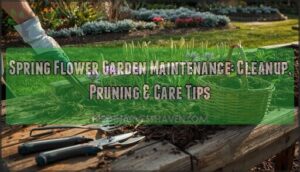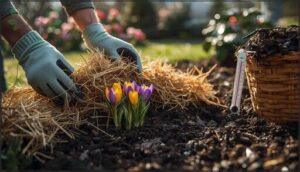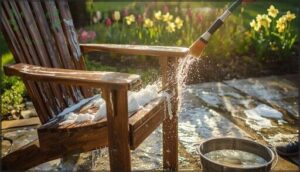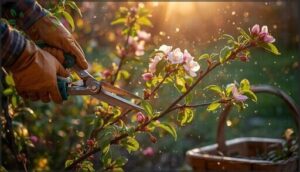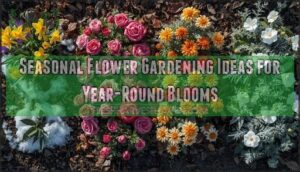This site is supported by our readers. We may earn a commission, at no cost to you, if you purchase through links.
Your perennials won’t forgive a half-hearted spring awakening. While neighbors rake and run, experienced gardeners know the difference between cosmetic cleanup and the systematic work that determines whether beds thrive or merely survive the growing season ahead.
Dead foliage harbors overwintering disease spores, compacted winter mulch invites crown rot, and that innocent-looking layer of leaves can slash root growth by nearly a quarter before you’ve planted a single annual. Effective flower garden maintenance spring routines address what’s invisible—soil compaction, fungal reservoirs, pest larvae tucked in debris—not just what looks untidy from the driveway.
The gardens that explode with color by June didn’t get there by accident; they benefited from deliberate early-season interventions that set the stage for vigorous growth, fewer disease pressures, and blooms that actually last.
Table Of Contents
Key Takeaways
- Spring cleanup must go beyond cosmetic tasks to address invisible threats like overwintering disease spores, compacted mulch that invites crown rot, and debris that can reduce root growth by 23%, as systematic early intervention determines whether beds thrive or merely survive the season.
- Timing your pruning correctly makes the difference between strong blooms and lost flowers—spring-blooming shrubs like lilacs set buds on old wood and need pruning right after flowering, while summer bloomers can be cut in late winter before new growth starts.
- Soil preparation through adding 2-4 inches of compost improves drainage by up to 60% and cuts waterlogging risk by 25%, while proper plant spacing doubles air circulation and slashes powdery mildew infections by 45%.
- Deep watering to at least one foot for annuals and two feet for shrubs, combined with drip irrigation that delivers 90% efficiency, builds vigorous root systems while keeping foliage dry to prevent disease and reducing overall water use by 60%.
Essential Spring Flower Garden Cleanup Tasks
Spring cleanup sets the stage for everything that follows—healthier plants, fewer diseases, and a garden that looks sharp from the start. You’ll want to tackle a few key tasks before new growth really takes off, focusing on removing what winter left behind and preparing clean, defined spaces for your flowers.
Here’s what needs your attention first.
Removing Dead Plant Material and Debris
Removing dead plant material from your flower beds isn’t just about appearances—it’s critical disease prevention. Fungal and bacterial pathogens overwinter in decaying stems and foliage, raising infection rates by up to 56% in beds left uncleaned.
Clearing dead plant material from flower beds prevents disease—leaving debris uncleaned raises infection rates by up to 56%
Clearing debris improves air circulation, accelerates soil sanitation, and reduces pest infestations by 40%.
Start your spring garden clean up by deadheading spent blooms and removing dead growth carefully with sanitized tools. Before beginning, consider the importance of pollinator safety to guarantee a healthy ecosystem.
Clearing Winter Mulch and Protection
Once you’ve tackled dead growth, turn your attention to winter mulch. Timing matters here—wait until soil temperature hits 65-70°F before removal, usually late April through mid-May.
Pull back coarse layers that block moisture and air, exposing overwintered pests for early intervention. Leaving mulch too long invites crown rot and fungal disease, while premature removal risks frost damage to emerging buds.
Proper winter mulch techniques, such as using the right winter mulch types, can help prevent these issues.
Cleaning Up Leaves and Lawn Debris
Beyond mulch, leaf debris demands your attention—especially in flower beds where leftover foliage smothers soil and chokes oxygen flow, cutting root growth by 23%. For spring garden clean up, rake thoroughly using debris removal tools like a fan rake or leaf blower. Average yards generate 10-20 contractor bags, costing $4-8 per bag for yard waste management.
Shred healthy leaves for compost using eco-friendly cleanup methods, but dispose of diseased material to prevent pathogen spread during your lawn clean up.
Edging Garden Beds for a Tidy Look
Once your beds are debris-free, sharp garden bed borders complete the transformation. Edge material options range from steel ($3.50–$8.80 per linear foot) to plastic, but re-cutting trench edges 2–3 times yearly—spring, mid-summer, and fall—delivers professional definition. Lawn edging tips: re-edge before mulching to contain material and prevent grass encroachment.
- Prevents root competition between lawn grass and your prized perennials
- Reduces weeding time by blocking grass creep into flower beds
- Elevates curb appeal instantly with crisp, architectural lines
Washing Patio Furniture and Outdoor Surfaces
While you’re sprucing up your flower beds, don’t overlook your patio furniture and outdoor surfaces—49% of Americans tackle these hard-to-reach areas during spring cleaning.
A garden hose and mild detergent (1 tablespoon per gallon of water) removes winter grime effectively, extending furniture lifespan up to three years.
Clean patios weekly in high-traffic zones for polished yard maintenance that complements your outdoor decorating efforts.
Pruning and Trimming Guidelines for Spring
Pruning in spring isn’t about cutting everything back—it’s about knowing what needs attention now and what should wait. The right timing makes the difference between encouraging strong new growth and accidentally removing this year’s blooms.
Here’s what to prune, what to leave alone, and how to time your cuts for the healthiest plants.
What to Cut Back for Stronger Growth
Cutting back dead stems in early spring can boost new shoot emergence by up to 25% in perennials like Sedum and Black-eyed Susan. You’ll want to prune most perennials to 1–2 inches above soil level once nighttime temperatures hold above 50°F for seven consecutive days.
This stem removal triggers hormonal reallocation, stimulating stronger regrowth and reducing disease risk by as much as 40% in susceptible species.
Pruning Ornamental Grasses and Perennials
Prune cool-season ornamental grasses between February and March, removing two-thirds of old growth while leaving at least one-third to support new shoots. For warm-season types, wait until March or April when green growth starts—trimming 3 to 6 inches above ground.
Perennials like coreopsis and sedum thrive when cut back to 6 inches, while echinacea performs best pruned to 12 inches above soil level.
What to Leave Alone Until After Bloom
Skip the shears on spring-flowering shrubs like azaleas, lilacs, and forsythia—pruning before bloom eliminates flower buds formed on old wood.
Let bulb foliage yellow completely after flowering; premature removal cuts next season’s display by 30–40%.
Perennials like coneflower and milkweed support pollinators, so delay cutback until new growth emerges.
Post-bloom care preserves bloom protection while supporting garden timing and flower preservation throughout your spring gardening tasks.
Tree and Shrub Pruning Best Practices
Healthy trees and shrubs start with smart branch removal. Take no more than 10–15% of live growth annually to avoid stress. Use clean cuts just above buds or lateral branches, targeting dead, diseased, or crossing wood first.
Hand pruners handle stems under ½ inch; thicker branches need pruning saws.
Early spring pruning, before buds swell, directs energy toward vigorous new growth while wounds heal fastest.
Timing Pruning for Flowering Shrubs
When you prune flowering shrubs dictates next year’s show. Spring bloomers like forsythia and lilac set flower buds on last season’s wood—prune them right after flowering ends in late May or early June. Wait, and you’ll slice off up to 80% of next year’s blooms.
Summer bloomers like hydrangea flower on new growth, so prune them in late winter before bud break.
Preparing Garden Beds and Soil for Spring
Once you’ve cleared away the winter debris and handled your pruning, it’s time to get your garden beds ready for the growing season ahead. This means more than just tidying up—you’ll need to address soil health, correct drainage issues, and make smart decisions about plant spacing.
Here’s how to set the stage for a thriving flower garden this spring.
Dividing and Replanting Overgrown Perennials
Overcrowded perennials choke themselves out—you’ll see fewer blooms and dead centers. Spring replanting every three to five years restores vigor and gives you free plants to expand your beds.
Perennial division requires clean, sharp tools and at least two healthy shoots per section. Plant at the original depth, water thoroughly, and watch your spring garden come alive with renewed energy and color.
Applying Fresh Mulch for Moisture Retention
After dividing perennials, you’ll want to lock in that moisture. A fresh 5–8 cm layer of organic mulching—grass clippings, bark, or hemp bedding—can retain up to 73–80% of irrigation water while cutting evaporation by a third.
Spring garden beds stay cooler by day, warmer at night, and need watering far less often. Your gardening checklist isn’t complete without mulch layering for moisture conservation and soil health.
Improving Drainage and Air Circulation
While mulch management boosts water retention, compacted clay soils can still drown your blooms. Work 2–4 inches of compost into beds—this soil improvement cuts waterlogging risk by 25% and lifts permeability up to 60%.
Wider plant spacing doubles air circulation, slashing powdery mildew by 45%.
For stubborn drainage problems, raised beds eliminate 70% of standing water incidents, supporting vigorous soil health and root aeration through better gardening techniques.
Planning for New Plantings and Filling Gaps
With drainage sorted, you’re ready to tackle those bare spots that weaken your garden design. Spring gardening means smart gap filling—choose climate-adapted perennials and cool-tolerant annuals for 42% better survival rates.
Map your garden layout before soil preparation begins, spacing transplants 8–12 inches apart to suppress weeds by 24%. Strategic plant selection and thoughtful growth strategies turn empty patches into flourishing beds.
Managing Pests and Promoting Healthy Growth
Spring brings more than just new blooms—it also wakes up a host of garden pests and sets the stage for fungal diseases if conditions aren’t managed properly. The key to a thriving flower garden isn’t just reacting to problems, but staying one step ahead with smart watering, careful observation, and practices that support both your plants and the beneficial insects they depend on.
Here’s how to keep your garden healthy and productive through the entire growing season.
Common Spring Garden Pests and Solutions
Aphids, slugs, and caterpillars top the spring pest lineup, but you’ve got proven options. Ladybugs can reduce aphid populations by 65%, while slug traps using beer cut numbers by 62%. For caterpillar management, hand-picking or biological controls like Bt achieve excellent results.
Regular pest monitoring with sticky traps boosts early detection by 52%, and organic solutions like neem oil offer 55% control without harming beneficial insects.
Preventing Fungal Diseases and Mildew
Prevention starts with sanitation methods—removing infected debris cuts fungal pathogen loads by more than 50%. Combine cleanup with strategic air circulation tactics and disease prevention becomes manageable:
- Space plants properly to reduce humidity and lower mildew risk by 40%
- Choose resistant varieties that slash fungal infections by 60%
- Prune dense growth to improve airflow and decrease outbreaks by 28%
- Apply potassium bicarbonate fungicides for 90% mildew control effectiveness
Deep Watering and Drip Irrigation Tips
You’ll achieve vigorous root growth by watering deeply—at least one foot for annuals, two feet for shrubs. A drip system delivers 90% irrigation efficiency while conserving water and keeping foliage dry to prevent disease.
Place emitters at each plant’s base, spacing them twelve inches apart in sandy soil for ideal soil moisture. This sustainable gardening approach reduces water use by 60% while fortifying your flowering plants.
Monitoring Plant Health and Early Intervention
Weekly plant health checks catch problems before they spiral out of control. Digital monitoring tools now detect stress with over 93% accuracy, while early warning systems track pest populations on seven-day cycles.
Your spring inspection routine should include:
- Inspect every 5–7 days for aphids, slugs, and fungal symptoms
- Document yellowing leaves or wilting with photos for trend analysis
- Remove infected plants immediately to prevent contagion spread
- Apply targeted treatments at first signs of powdery mildew
- Track open flower percentage to gauge overall garden vitality
This disease prevention approach cuts fungal incidence by 70% and boosts bloom production 15%.
Safe Practices for Beneficial Pollinators
Your garden thrives when pollinators do—bee conservation starts with timing cleanup six weeks into spring once temperatures stabilize at 50°F. Delay pruning dead stems until late May to protect 80% of overwintering native bees.
Switch to pesticide alternatives and apply treatments after sunset to cut pollinator exposure by half.
Plant 70% native plants in clusters for habitat creation, supporting twice the pollinator diversity while strengthening natural pest management.
Top 6 Tools for Spring Flower Garden Maintenance
Having the right tools makes all the difference when you’re tackling spring garden tasks. Quality equipment helps you work more efficiently and reduces strain on your hands and back during those long cleanup sessions.
Here are six essential tools that’ll help you prune, weed, cultivate, and maintain your flower beds with professional results.
1. Swiss Made Garden Pruning Shears
When you’re tackling spring pruning tasks on multiple shrubs and perennials, investing in quality Swiss-made pruning shears pays dividends season after season. Felco models like the FEL5 deliver clean, precise cuts through branches up to 1 inch thick thanks to hardened steel blades that actually gain sharpness with use.
The ergonomic rotating handle and forged aluminum construction reduce wrist fatigue during extended pruning sessions, while replaceable components mean you won’t discard the tool when a spring wears out—just swap the part and keep working.
2. Fiskars PowerGear Bypass Pruning Shears
If you prefer a lighter, more affordable option that still delivers excellent cutting efficiency, Fiskars PowerGear Bypass Pruning Shears offer outstanding value for everyday pruning and trimming tasks. The patented gear mechanism multiplies your hand force by three, letting you slice through 3/4-inch stems with minimal wrist strain—particularly helpful if arthritis limits your gardening time.
Precision-ground steel blades with non-stick coating resist sap buildup and maintain sharpness through hundreds of cuts. At roughly 8 ounces and around $25, these shears balance performance with accessibility, though the plastic gear housing requires gentler handling than all-metal alternatives when you prune shrubs heavily.
3. Fiskars Extendable Power Lever Bypass Lopper
When spring pruning extends beyond what hand shears can handle, the Fiskars Extendable Power Lever Bypass Lopper becomes your reach-and-cut solution. Power Lever Technology delivers twice the leverage of standard loppers, letting you prune shrubs and trim branches up to 1.75 inches thick without overextending your shoulders.
Telescoping arms adjust from 25 to 37 inches, keeping you grounded while tackling overhead growth. Fully hardened steel blades stay sharp through 600-plus cuts, and the lifetime warranty backs your investment in spring garden preparation.
Lopper blade maintenance remains simple—just wipe residue after use.
4. Fiskars Big Grip Garden Cultivator
If your spring cleanup list includes breaking up compacted soil or digging out stubborn weeds, reach for the Fiskars Big Grip Garden Cultivator. This hand tool stands out in Garden Tool Reviews for its padded, oversized handle—making long sessions a breeze and minimizing strain.
Offset tines glide through earth, boosting soil aeration and mixing with ease. From prepping beds to tackling spring garden maintenance, the cast-aluminum head resists rust and keeps going strong.
Rinse and hang dry—tool maintenance really is that simple.
5. Cobrahead Garden Weeding Tool
For those tough taproots or wiry clumps that resist every tug, the Cobrahead Garden Weeding Tool cuts through with precision and ease. Its curved, ergonomic design fits naturally in the hand—no matter your dexterity—reducing wrist strain during long weeding sessions.
You’ll breeze through your spring cleanup and speed up weed removal, thanks to the durable steel blade. Loved in Garden Tool Reviews for sustainable gardening, this weeding tool stands out: minimal fuss for maintenance, maximum effectiveness—exactly what your spring gardening checklist needs.
6. Corona Forged Hedge Shear HS 3911
Precision is paramount in spring cleanup—enter the Corona Forged Hedge Shear HS 3911. With heat-treated steel blades and a limb notch, it manages both fine shaping and stubborn branches, making it the multitasker your pruning techniques demand.
Gardening ergonomics shine thanks to non-slip hardwood handles, easing hand fatigue as you work through overgrown hedges. Blade sharpening is simple, keeping your hedge shears sharp for every pass.
Rugged tool durability and a lifetime warranty make this gardening tool central to routine garden pruning and hedge shear maintenance.
Frequently Asked Questions (FAQs)
How often should I fertilize spring flower gardens?
Most established perennial gardens thrive with fertilization twice per season—once in early spring and again after bloom.
Heavy feeders like daylilies may need supplemental midsummer feeding for ideal spring blooms and nutrient levels.
Can I plant summer bulbs in early spring?
Hold your horses—most summer bulbs need warm soil above 50°F before planting.
Store bulbs properly, wait until frost danger passes, then plant at correct depth for vibrant summer blooms without risking rot.
Should I deadhead spring flowers as they fade?
Yes, you should deadhead most spring flowers as they fade. Deadheading benefits include extending bloom periods by up to 30%, improving garden aesthetics, and redirecting energy from seed production toward healthier foliage and stronger reblooming.
Whats the best mulch depth for flower beds?
You’ll want to aim for 2–3 inches of organic mulch across your flower beds. This depth strikes the right balance—suppressing weeds, retaining soil moisture, and regulating temperature without risking root suffocation or drainage problems.
How do I protect flowers from late spring frosts?
Late spring frosts can devastate blooms overnight—but don’t panic.
Cover tender flowers with frost cloths the evening before predicted cold snaps, creating microclimates that raise temperatures by up to 4°C and dramatically reduce bud damage.
Conclusion
A client once asked why her neighbor’s daylilies bloomed six weeks longer than hers—same cultivar, identical sun exposure. The answer: disciplined flower garden maintenance spring protocols versus sporadic effort.
Your beds won’t reward shortcuts. Remove debris harboring pathogens, prune strategically before energy moves into stems, prepare soil when roots are actively regenerating.
The gardens that dominate July didn’t start strong by chance—they benefited from methodical work you’re completing right now.
- https://corporate.homedepot.com/news/products/new-home-depot-survey-reveals-americas-must-do-spring-projects
- https://blog.davey.com/should-i-mulch-in-spring-fall-or-before-winter/
- https://www.umass.edu/agriculture-food-environment/cafe/fact-sheets/fertilizing-flower-gardens-avoid-too-much-phosphorus
- https://plantologyusa.com/blogs/the-plantologist/spring-garden-pest-control
- https://richmond.ces.ncsu.edu/2016/03/spring-pruning-dos-donts/

